The Talk Sea Fishing Guide to coalfish fishing. Whether you want to target these species from the boat or shore, this comprehensive article gives you all the tactics you need to be successful.
Coalfish have many common localised names including saithe and the younger inshore fish being called podley's in Scotland, billet along the Northeast coast of England, coley in England, black jack's and sometimes glassan or glasshan in Northern Ireland, and Pysgod Ddu in Welsh, the latter due to their dark green to black backs. The abbreviated common name in the UK is "coalie".
Confusingly, on the east coast of America, this same species is referred to as "pollock" or "Boston blues". In Spanish, coalfish are called palero or Bacalao, and in French, it is Lieu Noir or Colin Noir, noir being the reference to the black back.
Although the flesh is grey, and many say it has a cotton wool like texture with little taste, there is a commercial value to this fish as being a shoal fish, it is caught in large numbers by trawlers. The main UK commercial catch goes to the French market, with smaller general markets throughout Europe. The flesh can be salted and smoked to achieve a salmon-like colour, and this is called "Sea Salmon" in Germany. It is also used extensively for cat food products.
There were some huge coalfish recorded in the early days of wreck fishing from the mid to late 1960s and 70s. Their size just kept creeping up through the next two decades, and in 1986 the existing British Record Boat Caught coalfish was caught over a wreck south of Plymouth at 37lbs 5ozs by a Mr D. Brown.
Anglers were drawn to this species because of its fighting ability, and it's tendency to crash-dive during the fight, ripping many yards of line off the reel. It remains a popular target, though for the very big fish anglers now travel to the Norwegian fjords where coalies regularly top 30lbs in weight.
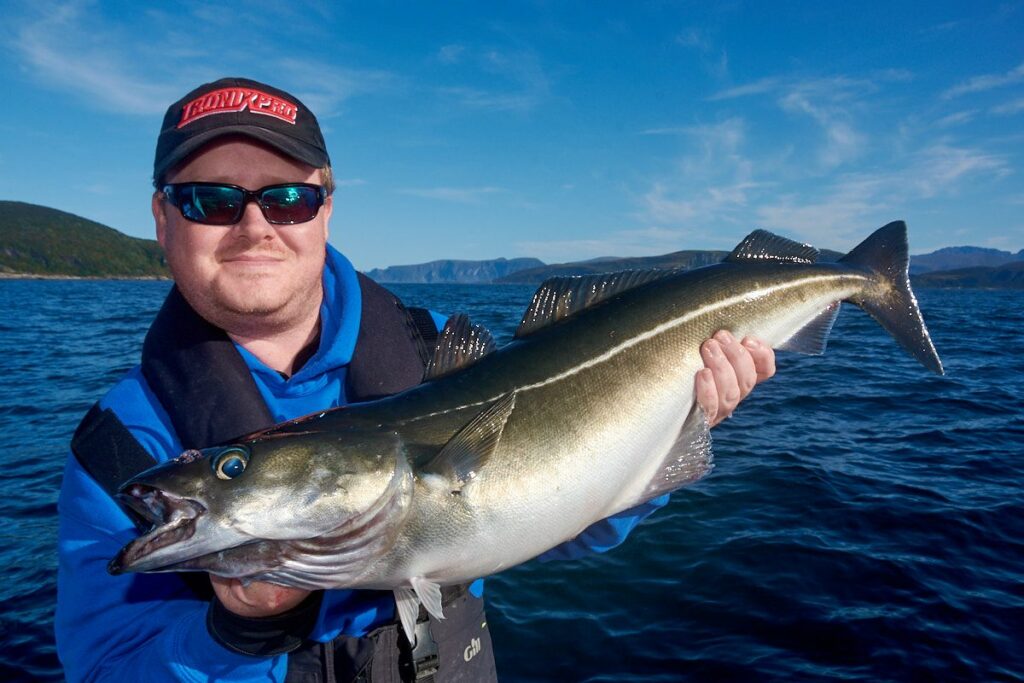
It's unlikely, but the coalfish and pollack inhabit much the same water, so there is a chance of misidentifying them. Several indicators are there for relatively instant recognition of the coalfish. The jaw protrudes only very slightly on the coalie, but the jaw is visibly longer than the upper jaw in the pollack. The real giveaway is the coalfish's lateral line, which is virtually straight and noticeably white running from the gill cover to the tail. The lateral line on the pollack, in contrast, has a noticeable curve over the pectoral fin. The coalfish's forehead is also more round when viewed from the side profile.
The colouration is a dark green to black back, quickly giving way to dull silvery sides and belly.
Coalfish are found from the Bay of Biscay, throughout the English Channel and the North Sea, all along the Norwegian coast and round to beyond the Russian border. They are common around Iceland, too.
They are residents around the whole of the UK and Ireland but are a cold water loving fish, so the better numbers tend to concentrate in deeper water and the further north you go.
Since the early 1980s, the coalfish have reduced in numbers inside the English Channel, with big wreck fish now far less common. This is thought to be due to commercial overfishing and warming seas pushing the cold water liking coalfish further north.
They generally spawn from January through to late April, but it can be later after colder than average winters. Typical depths for spawning are 100 to 200-metres. The eggs and larvae then drift near the surface carried along and distributed by natural sea currents to the coastal nursery areas.
The juvenile fish live inshore in harbours, estuaries, and are common off the beaches, especially rocky beaches and deeper water off open rock ledges. But at a weight around 2lbs, they make a natural migration offshore and seek out either rough reef ground with rising pinnacle rocks or more so wrecks.
Juvenile fish will live in rock pools in the north, but typically run sandy surf beaches in just a couple of feet of water. The coalfish has been recorded deeper than 300-metres, but their natural depth is down to 200-metres offshore.
As juveniles, they eat worms and mussels, small crabs, and sandeels. As they grow and reach adulthood, their diet changes to be wholly fish, mostly sandeels, herring, mackerel, small whiting, pout, poor cod and rocklings.
Coalies have been caught commercially to over 70lbs, but in UK waters currently, 20lb plus coalies can be classed as huge, with anything over 15lbs classed as a specimen. In Norway, you have a real chance of 30lbers, and just possibly a 40lb plus fish, especially in the far north.
Like so many fish, the coalie can be caught throughout the full 12-month period in UK and Irish waters, especially over wrecks. The bigger fish are best targeted from October through to April when the water temperature is colder and the fish more active. This especially applies in the southern half of the UK where summer catches tend to be dominated by smaller sub 5lb fish, generally speaking, with an influx on to the wrecks of bigger fish from October onwards.
These shoal fish are often of a close uniform size and available in large numbers, especially over deep reef ground. When you come across a shoal of small coalfish, it can prove impossible to get through to reach bigger fish or different species below them.
When both wrecking and reef fishing, the tides are important in so much as they, along with the wind, dictate the boat's drift speed. Ideal conditions are small neap tides and minimum windage so that the drift of the boat is both predictable and slow. This keeps the boat over the target wreck or reef, and the fish, longer maximising catches.
In windier conditions, look for a wind direction that blows against the tide's flow. The wind helps to slow the boat's drift, and again it keeps you over the fish longer.
Generally speaking, the bigger tides will, in many areas, see a fast tide flow and fishing in deep water over reefs and wrecks becomes more difficult. But not all areas see a fast tide run during the spring tides, and if the skipper can find target marks away from the main run, then fish can still be caught.
The state of the tide will affect the shoals of coalies. Typically, they drop down tight around and just above the wreck or reef. Usually, just down tide of it in the slack water bubble created as the tide flows over the structure. This lifts the main tide flow in the water column and as it does so, creates a bubble of slack water underneath. As the tide flow eases towards slack water, the shoals of coalies will lift in the water column.
Coalfish are more contrary and less predictable than pollack when it comes to how the tide state affects this change of water depth. This is a generalisation, we know, but something we've seen many times in the past. The bigger coalfish will stay fairly tight to the reef or wreck base, often just below the main pollack shoals. The smaller shoal coalfish will tend to be much higher up in the water and often above the main pollack shoals. It's not uncommon to find coalfish hanging in numbers in mid-water in overall depths of 300 to 400-feet with the pollack just 20 to 30-feet off the seabed. If you want coalfish, then really search the depths to find them. A good way to do this is to have anglers all fishing at different depths until the fish are located.
As for feeding over wrecks, coalfish are voracious and will feed heavily, but this tends to be concentrated in the first two to three hours of the flood and ebbing tide with catches reducing either side of slack water. When the target fish are smaller on reefs, they will feed whatever the conditions.
Something to bear in mind when wrecks are inundated with huge numbers of coalies up to about 4 or 5lbs is that they tend to beat any bigger fish to the lures. A good skipper will note exactly which wrecks have the smaller coalfish shoals present and move off these onto wrecks where they are not present. This scenario sees the bigger double-figure fish caught when they do not have to compete with the smaller fish.
Smaller coalies will be present over rough ground, but they will gather in smaller clusters, not bigger shoals necessarily, around any rising peaks or on ground that is very uneven with a mix of smaller and much bigger boulders. It's a case of drifting over this ground until you come across pockets of fish. There is evidence to suggest that one or two coalies will live with pollack of about the same size over and around a specific bit of ground.
Reef ground with high rising rock pinnacles offers much better prospects with single bigger coalfish often resident around their base. You rarely get the numbers of fish on this higher ground, but you will get better quality.
Coalfish of all sizes love wrecks. It's obvious why. Wrecks not only deflect the tide sheltering them, but wrecks hold and attract a vast amount of food fish such as sandeels, sprat and small whitefish. The bigger fish will always be tight to the wreck itself, often right in amongst the wreckage. However, though present on whole wrecks, the smaller shoal fish prefer wrecks that have blown up and split in two on the way down, throwing a wide debris field around them. These tend to be the wrecks that produce the larger numbers of fish, but not necessarily the biggest fish. On the wide debris field wrecks, the shoals can be huge and spread across the whole wreckage area. On wrecks that have gone down intact without breaking, then expect the coalfish shoals to be more compact and closer to and immediately above the wreck or in the downtide bubble of slack water.
Weather patterns do not overly affect the coalfish shoals. What prolonged rough seas will do is push the shoals deeper, so if they were on shallower wrecks and reefs closer to shore before the blow, then expect them to have moved out deeper as the blow passes through and the seas start to ease.
Periods of calmer weather improve water clarity, making a difference to catches. Ideal conditions are clear water. Any suspended sediment in the water seems to harm catches.
Even though we're fishing at depth mostly for coalies, you'll find that days when there is an overcast sky will fish better than days when the sun is high and bright. On overcast days the light levels reduce as there is less direct sun to penetrate through the water column. Also, on dull days, the fish will tend to be higher in the water column, and deeper down when the light levels penetrate deeper in bright sunshine and clear skies.
In shallow inshore water, the light levels become much more important, and the fishing will be far more consistent on dull days than bright days. Again, expect coalies to be tight to the seabed in clear skies, but more likely up in the water column on dull and overcast days.
If you're able to fish a wreck or reef as the light levels fall towards dusk, then anticipate a gradual rise in the water column of the coalfish shoals. They may even push bait fish right up to the surface layers even in 200 to 300-feet of water at this time. The opposite applies if you begin fishing as dawn breaks. The coalfish will be higher in the water column to begin, but then drop deeper as the light levels increase.
In shallow inshore waters, a light 12lb class rod with a multiplier holding 300-yards of 20lb braid is ample for any coalies you're likely to hook. Some anglers looking for the maximum sport will change to a 9ft spinning rod rated to 3ozs and match this to a size 4000 reel loaded with 20lb braid. Even a 4lb coalie can fight hard on this gear making short searing runs.
Over reefs and wrecks, heavier tackle is needed. A sporting soft-tipped rod with a fast action in the upper middle section feeding into a stiff butt is perfect. The reel to go with this rod is typically a multiplier holding 300-yards of 30lb braid, plus a little backing. Ideally, given the depths you might be fishing, choose a faster retrieve model, something with a gear ratio around the 6:1 mark. This means you can retrieve tackle from the depths much quicker maximising fishing time and making light work of winding in, which with slow retrieve reels can be physically draining over a day's busy fishing.
If fished direct to the terminal tackle, braid will inevitably come into contact with wreckage and debris. If you add a short shock leader of fluorocarbon with the same breaking strain as the braid, this will protect the more expensive braid and limit tackle losses due to line abrasion. As we say so often, this short section of clear line also helps to give a separation between the coloured braid and the terminal tackle. This can be very important when fishing deep clear water when visibility from the fish's perspective is more distinct. This simple addition can double your catches on a difficult day, which is why we keep mentioning it.
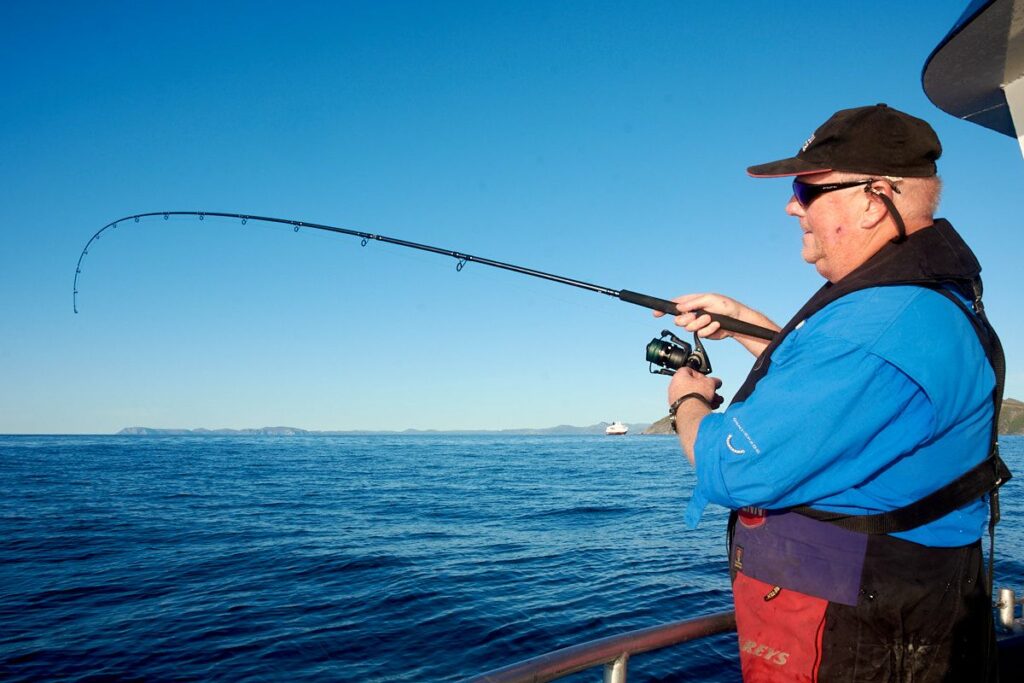
At the depth we're generally fishing, rigs need to be simple and tangle-proof. Here at TSF we also like to reduce rig components to a minimum to reduce both the cost of lost tackle, but also to limit the chance of tackle snagging in the wreckage, plus to reduce as much as possible the visual effect on the fish of the terminal tackle as it takes the lure.
Whitby Rig
A rig we particularly favour is the modified Whitby rig. It's minimalistic but exceptionally effective. Here's how we tie it.
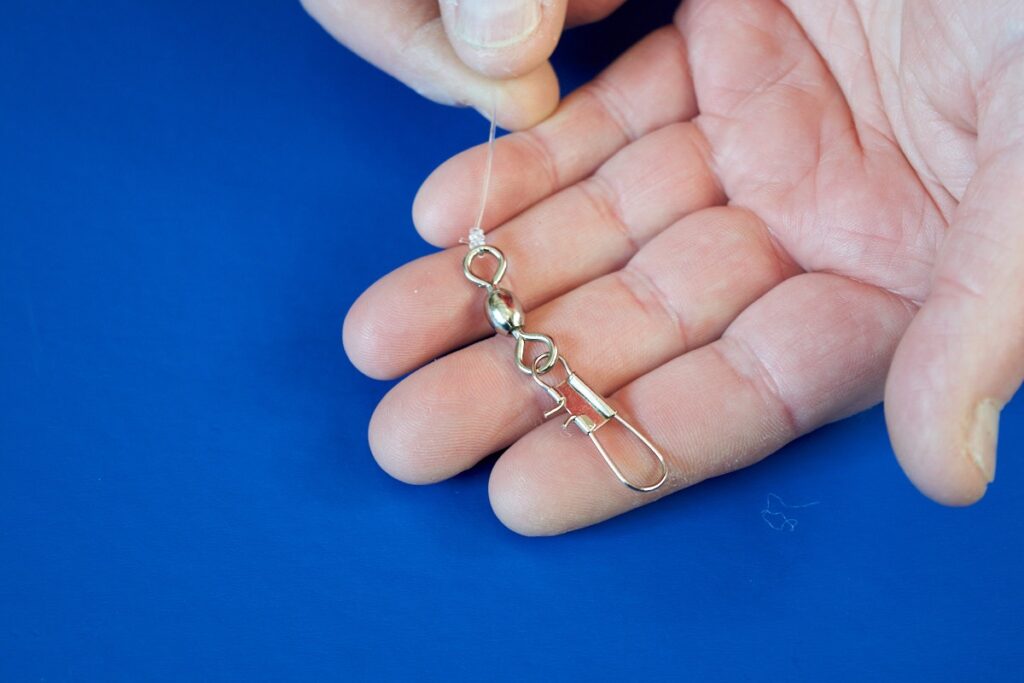
1. On to the shock leader tie on a size 2/0 American Snap Swivel.
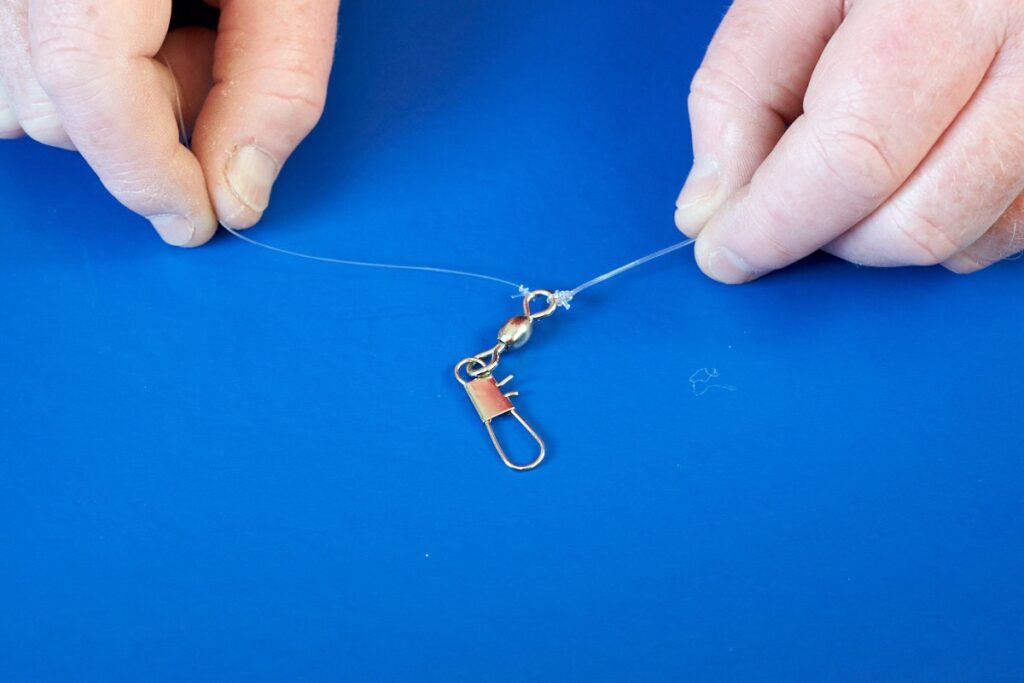
2. To the same eye you tied the leader to, tie on 7ft of 30lb Fluorocarbon line.
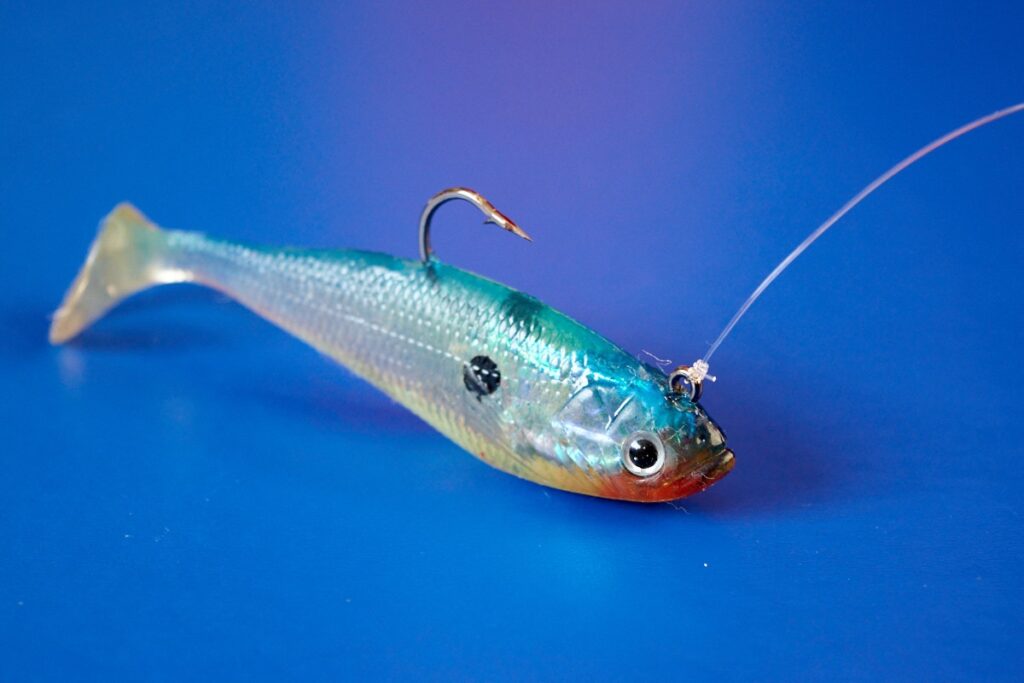
3. To the Fluorocarbon tie on the lure of your choice.
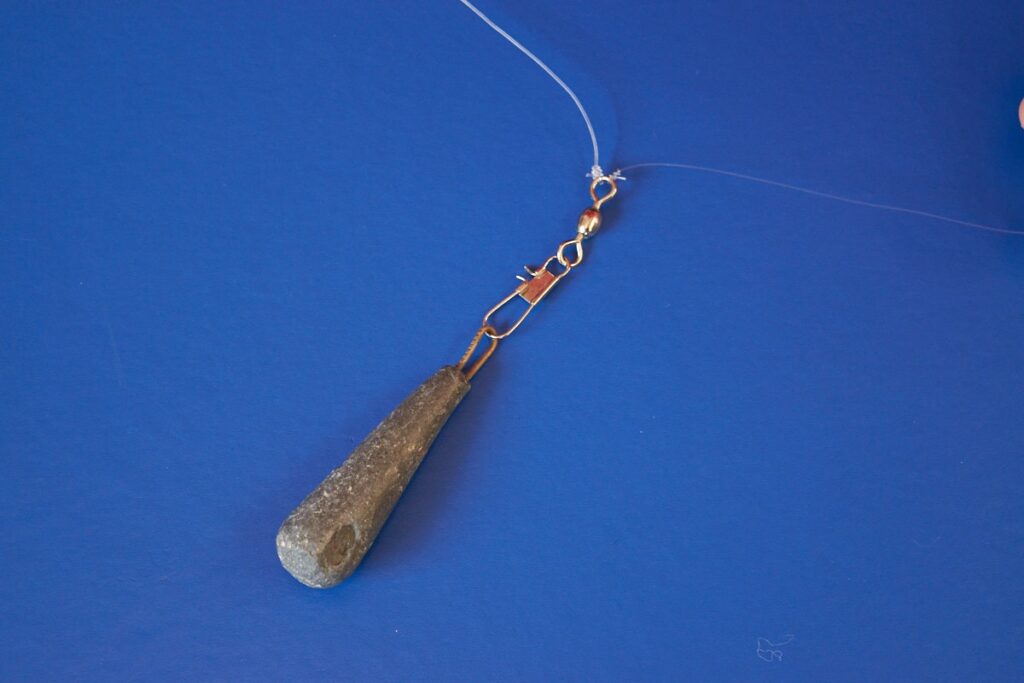
4. The lead weight attaches to the link on the Snap Swivel.
The use of the weighted lure on this rig is vitally important. The rig is free to descend at full speed down through the water column. When the lead weight hits the seabed, immediately start to wind in and retrieve line. As the lead weight is coming back up, the weighted lure is still descending, and it's the inertia of the weighted shad still descending as it passes the lead that will pull out any tangles or twists in the hook length.
Mostly, a 7ft hook length is enough directly to the lure. However, if you find that you're not getting takes, or takes are unsure with the fish just plucking at the tail, then lengthen the hook length by 2 or 3-feet. This gives the lure slightly more movement, but more importantly gives a greater separation area between lead weight and lure, which can make a major difference.
This rig can also be modified instantly into a hopper rig where the lead weight is only raised off the seabed a few feet, and then the rod tip is lifted up and down to hop the lure up and down just above the seabed. This is a deadly method for bigger coalfish if you're willing to risk the lure right in the wreck at deck and debris level. When changing to a hopper rig, we normally prefer just 4ft of heavier 40, or even 50lb fluorocarbon or stiff mono as the hook length. When working the lure right in amongst the snags, the heavier hook length offers better abrasion resistance. The stiffer nature of the heavier hook length further eliminates any tangling issues.
Flying collar rig
In our opinion, the Flying Collar Rig is now outdated. It is a very effective rig, and much loved still by many anglers which is why we've included it, but the reality is that it needs a flowing tide to work effectively, plus it has to be let down to the seabed very slowly to avoid the long trace tangling.
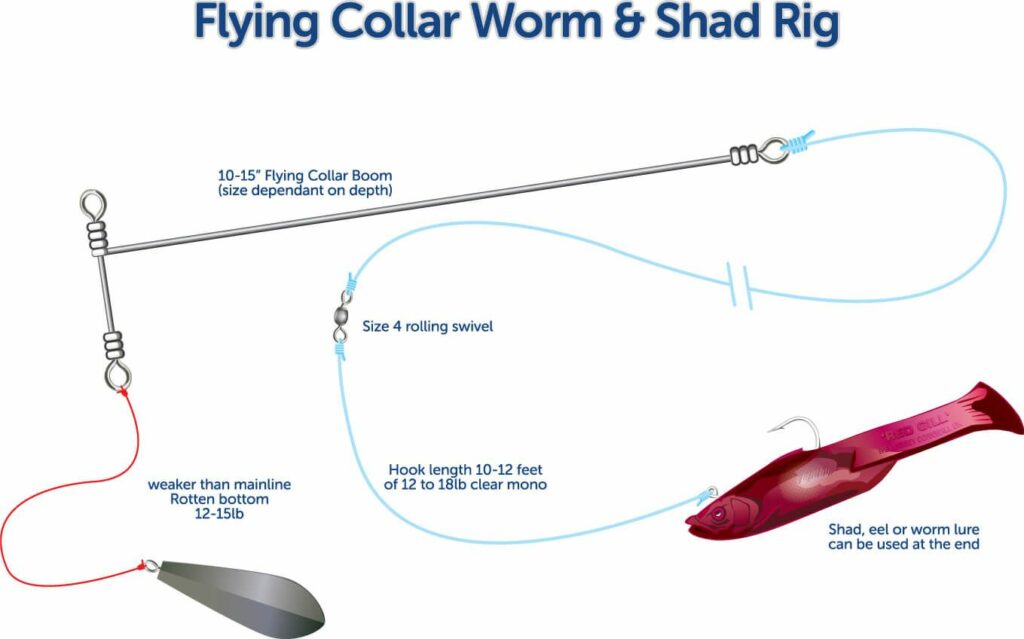
This rig is ok for retrieving lures up through the water column, but that's it. As mentioned, it must be let down to the seabed very slowly with occasional pauses; otherwise, the long hook length can tangle with the boom and the shock leader. To help minimise this happening, make sure you cut the rig knots' tag ends as close to the knot after full tightening as you can. Often the long trace will hang itself up on a tag end and cause repeated issues if you ignore this point.
When the tide is flowing strongly a 15ft hook length should be ok, but reduce by a third during slack water periods.
2-Hook Killer Gear
This can be a very effective rig for shoal coalfish if you want multiple catches. It presents both a lure and bait together to maximise the visual and scent combination, so it is a good one to use if the water carries some colour.
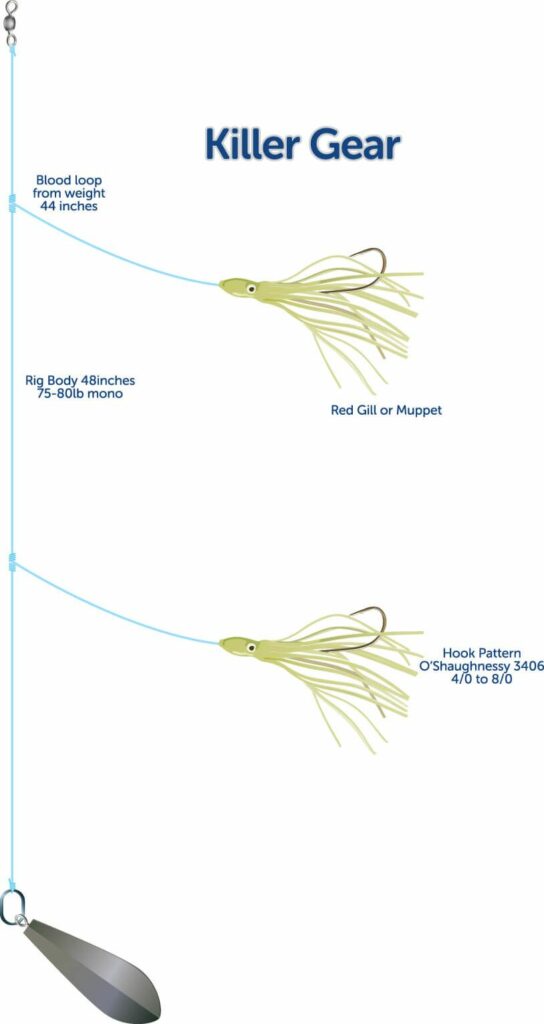
The way the muppet is rigged is important. Cut just the tip of the nose off the muppet leaving a hole just big enough for the line to pass through. Slide on an 8mm plastic bead, then tie on the hook. The bead and the muppet now slide down to butt up against the eye of the hook, but can't pass down onto the hook shank. All that's left to do is to bait the hook with a small fillet of mackerel, squid or herring.
The muppet adds colour, but the legs also give movement and vibration, and coupled with the bait scent, it makes it easy for the coalfish to find the lure and bait. Use smaller muppets up to about 4-inches for this.
These are excellent takers of coalfish, especially when they are feeding on small prey fish such as sprat. They are usually made on a very heavy commercial mono and come as a six-feather rig. They need to be reduced to just three feathers for angling purposes. Don't try to be greedy by fishing more as you could get a 5lb plus coalie on each feather and they all want to go a different way, usually resulting in a breakage. They are most effective if the hooks are baited with fish bait such as mackerel, bluey or squid.
The fishing technique is simple with the feathers fished on a tight line and movement added by simply lifting and lowering the rod tip a couple of feet. Presented in this way they imitate a small shoal of fish rising and falling in the water column.
To add further attraction, try fishing the feathers with a luminous green coated lead weight. This is especially effective in very deep water.
With so many artificial lures available nowadays it's hard to pin down just a few top performers. In truth, on their day, most lures will catch fish. However, it makes sense to try and match the type of prey the coalfish are currently feeding on as near as you can. This means we need to carry a few patterns in different sizes.
Without doubt, shad patterns are deadly for the bigger fish, especially those between 3-inches in length and 6-inches. Look for those with a thin tail section but with a large wide tail. These will give the best movement and vibration in the water. A good one to judge others by is the Berkley Ripple Shad, Berkley Powerbait Pulse Shad and anything similar.
If you like the look of a shad pattern, don't worry if it does not come in a weighted version, just use a jighead or lead-head, the effect is the same.
Sandeels are must-have lures too - these need to be in sizes from 4-inches to 10-inches, again with a wobbling tail. Savage Sandeels and the Berkley Powerbait sandeels are both excellent. We also rate the grub type, or Mr Twister lures, especially the black-bodied ones with a brighter red, orange, or green firetail.
Colour is also important. Good cold colours to carry are black, red and green. These are good choices in clear seas but with low light levels entering the water. These colours give a dark shadow or silhouette that the fish can pick out from below and give chase.
Look at yellow, orange, rhubarb and custard and pink in the hotter colours. These are best used when the water has a hint of colour after a storm. That said, coalfish are different from pollack and seem to take hot colours better. We'd have no hesitation in trying a lumo green lure or a hi-viz pink in really murky water as these will consistently take coalies.
We also like clear or transparent lures and have done well on these in the gin-clear Norwegian fjords for coalies, so a few of these are also worth carrying.
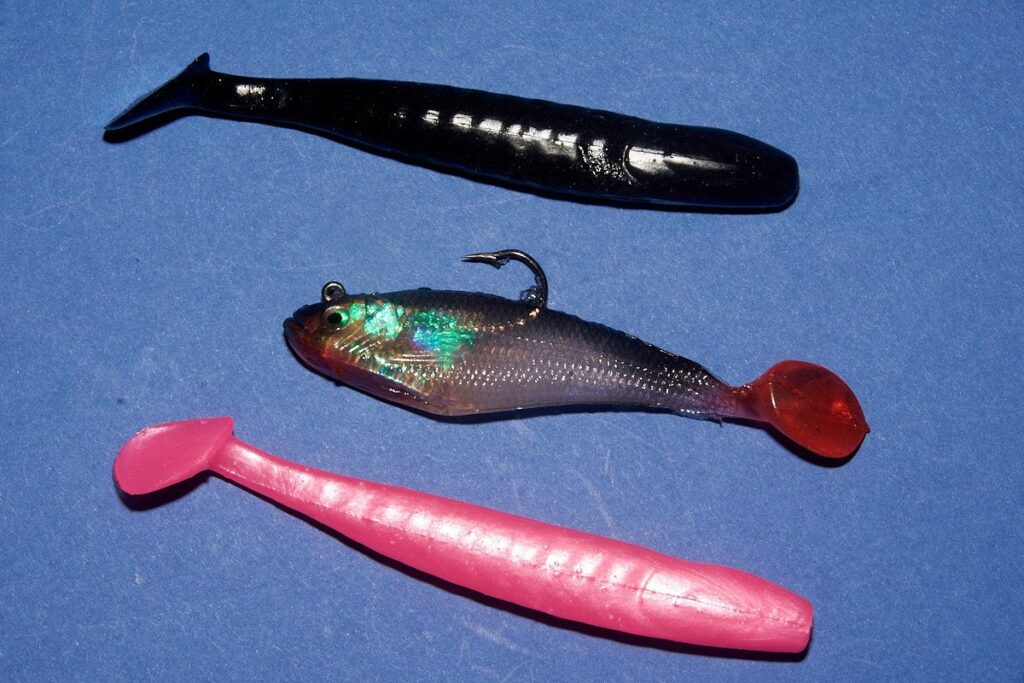
We'd probably choose the hopping rig for reef fishing as the best option, to begin with. This needs the weight to be dropped to the seabed, and as the weight is felt to touch bottom lift the rod tip and retrieve 2-feet more than the total length of the hook length, so with a 4ft hook trace retrieve 6 to 7-feet of line. Now simply work the rod tip up and down a couple of feet or so at a time so that the lure lifts nose up a short way, then drops back nose first. This tactic only works really with non-stretch braid lines. Mono lines stretch too much and nullify the rod tip lift when fishing at real depth. The coalies, especially bigger ones, will hit the lure as it drops. If you're not getting bites, then lift the lure higher until you find the fish. You get one slam on the rod tip, and then the fish takes off pretty much setting the hook itself.
Over a wreck, then it's likely you'll be using the Whitby Rig with the longer 7ft to 9ft hook length for retrieve fishing. Again, let the weight descend until it hits the seabed, then instantly start to retrieve using a slow to medium pace. Count each full turn of the reel handle as the lure edges upwards, and when a bite comes, it gives you an idea of where the fish are holding in the water column. This will keep altering as the tide changes, so make this a natural part of your fishing. If you don't get takes, then try a faster and faster retrieve, or a slower retrieve with brief pauses once the lure is up safely off the bottom and away from snags. Takes from coalies are usually decisive with a sudden gulping in off the lure and the rod tip bending over.
Also, listen to what the skipper says regarding where the boat drift is related to the approaching wreck. As you approach the wreck, and with your terminal tackle touching the seabed, deliberately hold the lure on a tight line above the seabed even allowing it to lift slightly in the water column as the line comes tight, but when he says "wreck approaching" release line quickly so that the lure hits the seabed again just before the boat is over the wreck. Now, without retrieving line yet, just let the lure lift up at a shallow angle off the seabed as the line tightens. This brings the lure upwards over the wreck at a shallow but ever-rising angle. This can be deadly when you get it right. Coalfish are more aggressive takers of lures than pollack, and you'll feel a sudden jag on the rod tip as the lure is taken.
The 2-Hook Killer gear is a simple form of fishing. Just let the tackle down to the seabed then gradually lift it up in the water column by lifting and lowering the rod tip and retrieving line as you drop the rod tip. Again, takes from coalies are sudden crashes of the rod tip as the coalie takes the lure and bait.
In recent years, due to warming seas and milder winters, the best of the winter shore coalfish action is north of a line drawn from North Wales across to the Northeast. South of that line coalfish can be more localised in distribution, mainly near rocky coastal areas, especially in the west of the country.
Although very small coalfish (billet) can be caught in harbours and estuaries throughout the year, the season for shore caught coalfish is typically from late October to late March along the open coastline. Their numbers build inshore from that mid-October period, but you see the best numbers in the southern section from Christmas through to mid-March. In the north, they are far more frequent and wider spread.
For most beach fishing you'd be wise to choose any rising tide in the few days before the biggest spring tides. The fish are more actively feeding then and will range further afield. The beaches tend to fish less productively during the neap tides but will still produce.
That said, on the neap tides, some of the estuaries, especially the smaller ones, can really come into their own due to the faster tide run in the main estuary channels and you'll catch coalies from this main channel as they range up and down, but still within close proximity to the sea itself.
It's the same in smaller harbours. They use the flooding tide to range as far up as the saltwater content allows them, but no further. They will do this on most tides, but the biggest numbers of fish will be evident on the rising tides up to the spring tides.
They feed best on the incoming flooding tide and much less on the ebbing tide. They like a little water flow, so always bear this in mind.
They love clean sandy beaches with rocky headlands and cliffs either side of them, especially if there is rougher ground further out. They work their time on the rough, then swing in with the flood tide to run the surf line where the flooding tide washes food out from the sand.
They are found over rougher broken ground, also sometimes on rocky ground, though their preference is for some sand when tight inshore.
Small coalies are also common off breakwaters, jetties and piers, also harbour walls.
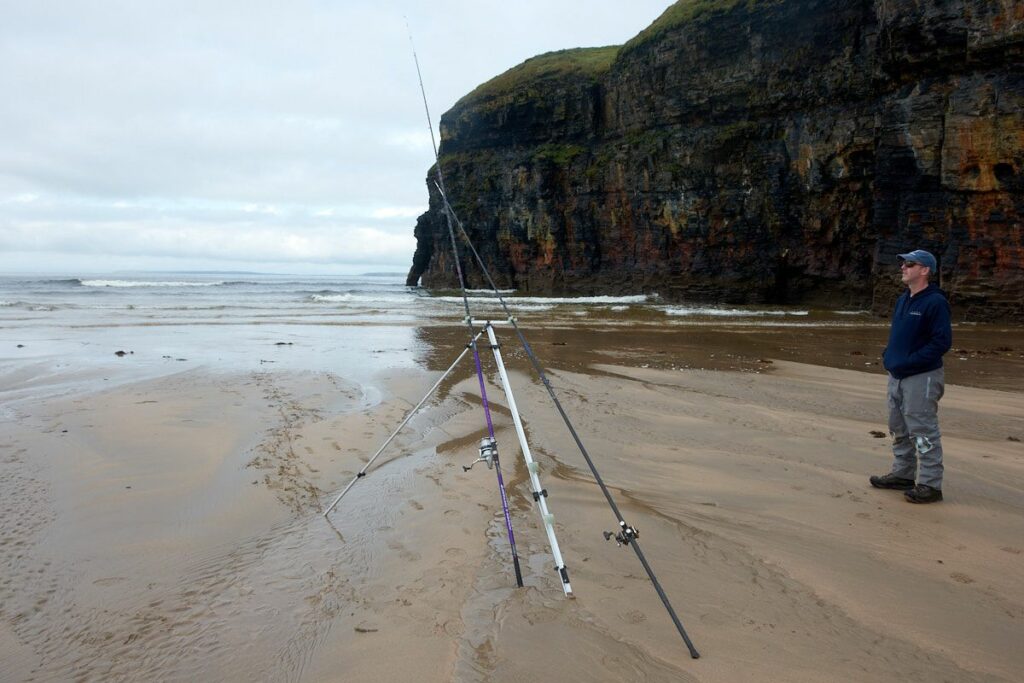
Coalfish will run in a decent surf on surf beaches, but they don't like it too rough with a high surf. They like to run very tight inshore, often less than 30-yards from the sand line, so heavy surf is not to their liking. Look for a predictable, light to medium surf with some width to the surf tables.
They can be caught in daylight if the sea is coloured and the sky cloudy, but they are best fished for in the dark hours, especially off the beaches. It's less important when fishing off man-made structure and inside harbours and estuaries.
Due to the terrain you're fishing with potential weed, also rougher ground patches, stick to a standard 4-6oz beachcaster between 12ft and 13ft long in partnership with a multiplier reel such as the Penn 525 series, the Abu 6500's, or the Akios and Daiwa equivalents. Load the reels with 18lb mono and a shock leader.
The other obvious outfit is a 13ft to 14ft continental style beachcaster with a shallow spooled 7000 sized fixed spool reel. Load with 30lb braid mainline and add a 60lb to 80lb braid shock leader.
Inside estuaries you may get away with a bass rod capable of casting 2-4ozs, a small 6500 multiplier loaded with 15lb line and a 30lb shock leader, or a 5000 sized fixed spool with 20lb braid and 40lb braid shock leader. This outfit gives a bit more fun for a fish that can fight well above its weight, but things like tide run and weed will govern your everyday choice.
You don't need complicated rigs for shore coalies. We use our reversible 3-hook flapper, and it will maximise your catches, not just of coalies, but of other species at this colder time of year.
3 Hook Reversible Flapper Rig
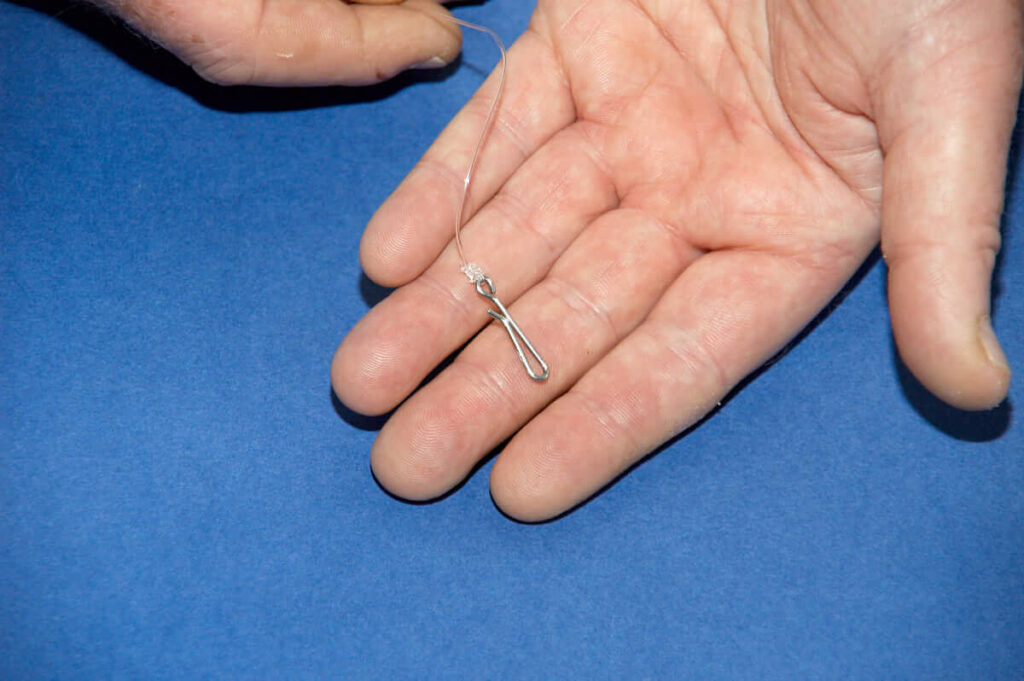
1. Start with about 64-inches of 60lb clear mono. Tie on a Gemini lead link at one end.
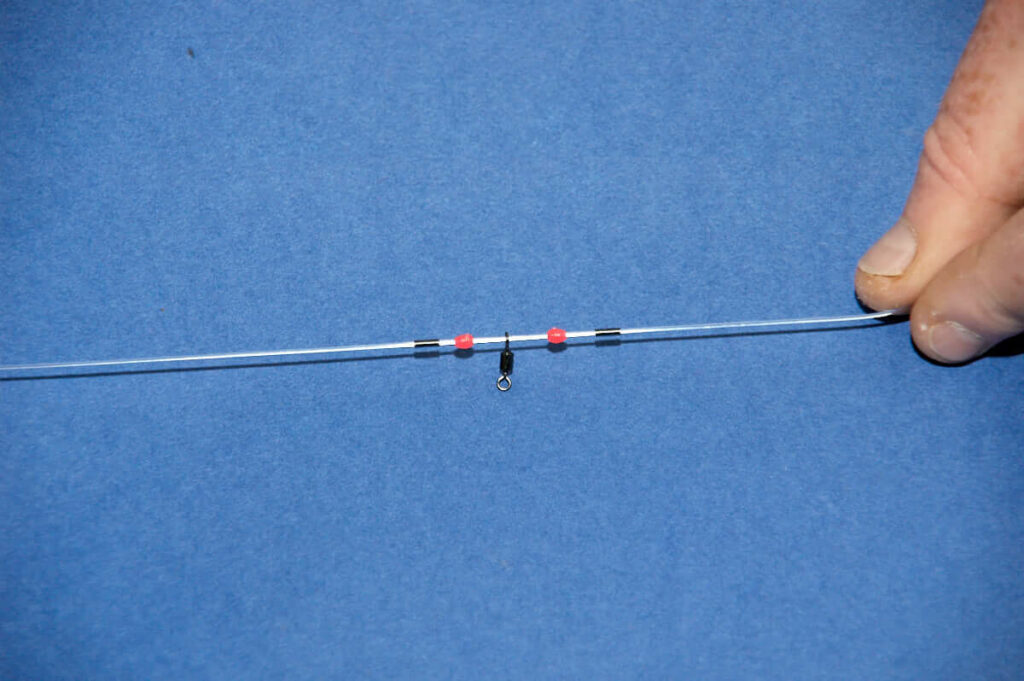
2. Slide on a rig crimp, a 3mm oval rig bead, a size 10 swivel, another rig bead and a crimp. Repeat this sequence to give you three full individual sets of crimps, beads and swivels. Leave these loose for now.
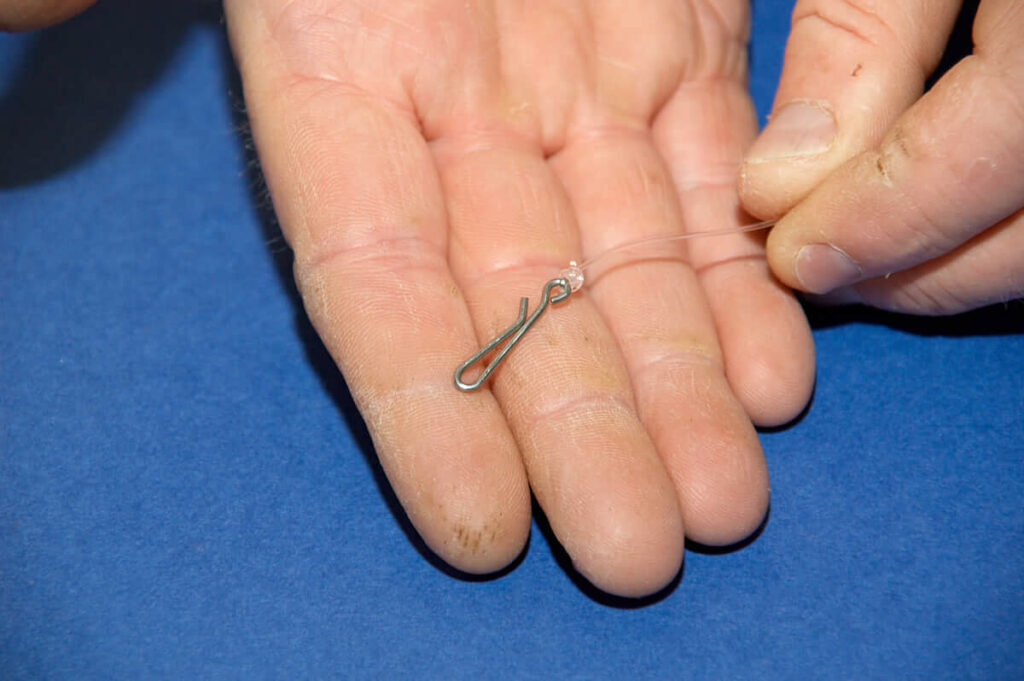
3. Complete the rig by tying on an inverted (upside down) Gemini lead link to the tag end of the rig body line.
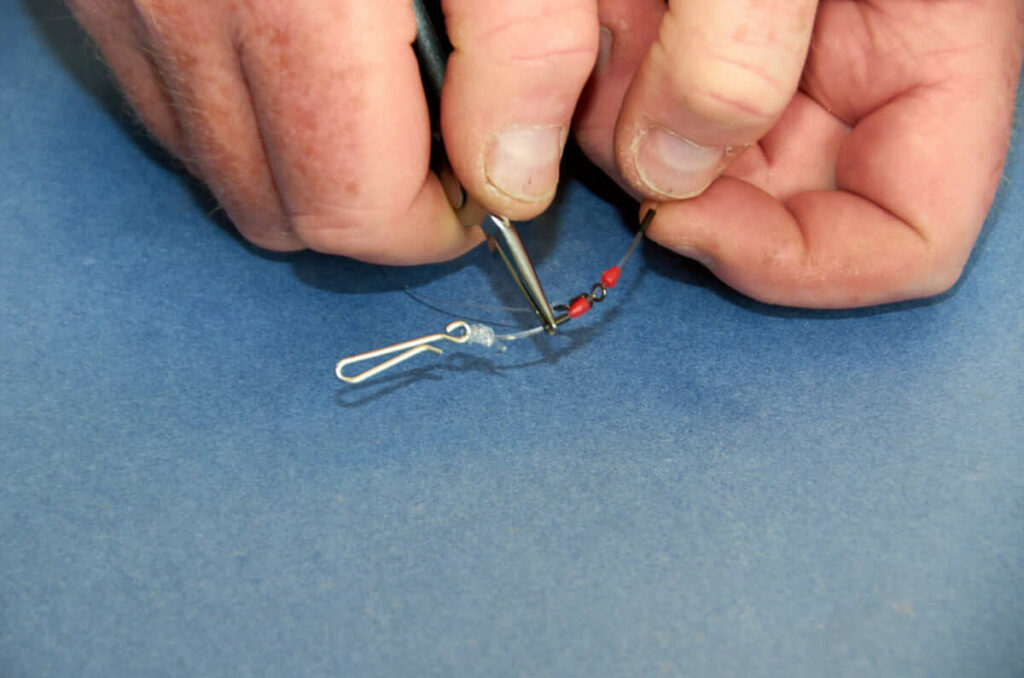
4. The first hook trace swivel needs to be placed just one inch below the top Gemini lead link. The middle swivel should be positioned exactly 17-inches below the top swivel, and the third again 17-inches down from the middle hook trace swivel.
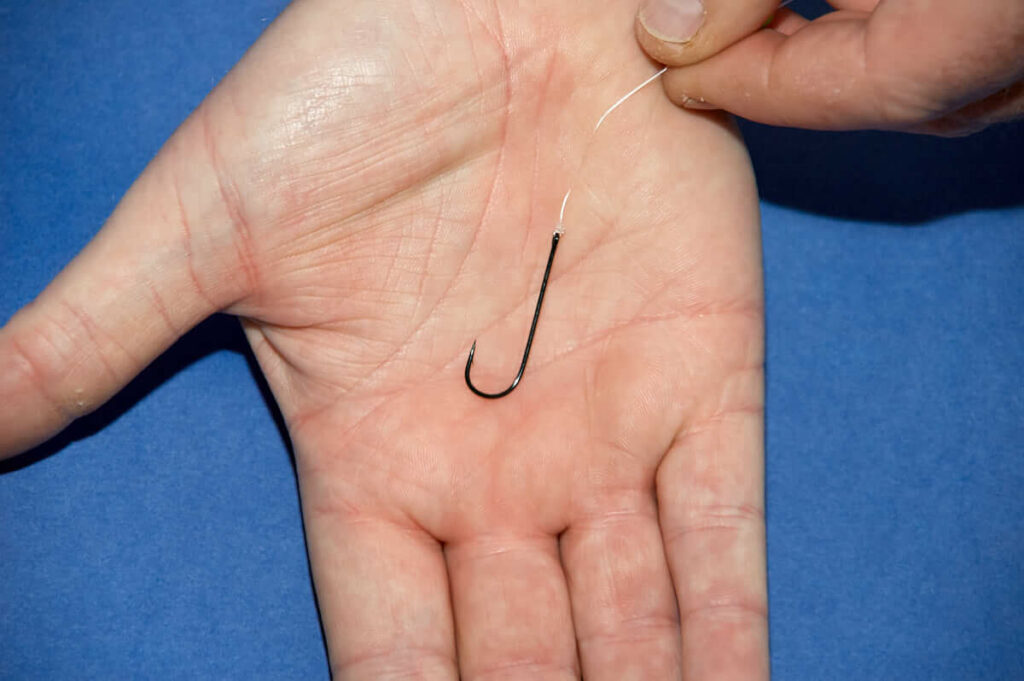
5. The top hook trace needs to be the longest at about 15-inches, the second hook trace measures 13-inches, and the bottom hook trace is the shortest at just 10-inches. All hook traces are made from 20 mono or fluorocarbon and are finished with a size 2 Kamasan B940 hook for general species.
The way this rig works is that due to it having Gemini clip links at each end, you can reverse the rig. This is handy if you notice that the lowest hook well above the lead weight is catching most of the fish with the upper hooks redundant, then reverse the rig so that the hook nearest the clip link which was the highest hook, becomes the lower hook fished tight behind the weight, with the middle hook now also positioned lower. This simply means you have not just one hook in the feeding zone, but two increasing overall catches.
Don't go any higher in size than the 2 Aberdeen hooks. Even a bigger 2lb to 3lb coalie can easily be landed on these.
When in the surf the coalies will take all the usual baits including black and blow lug, rag, razorfish and small sand clam.
The best baits though are fresh and frozen crab and mussel. The crab needs to be cut into sections just big enough to fill the hook bend and shank, leaving the hook point clear, then binding it quite tightly with a few wraps of bait elastic into a rough sausage shape.
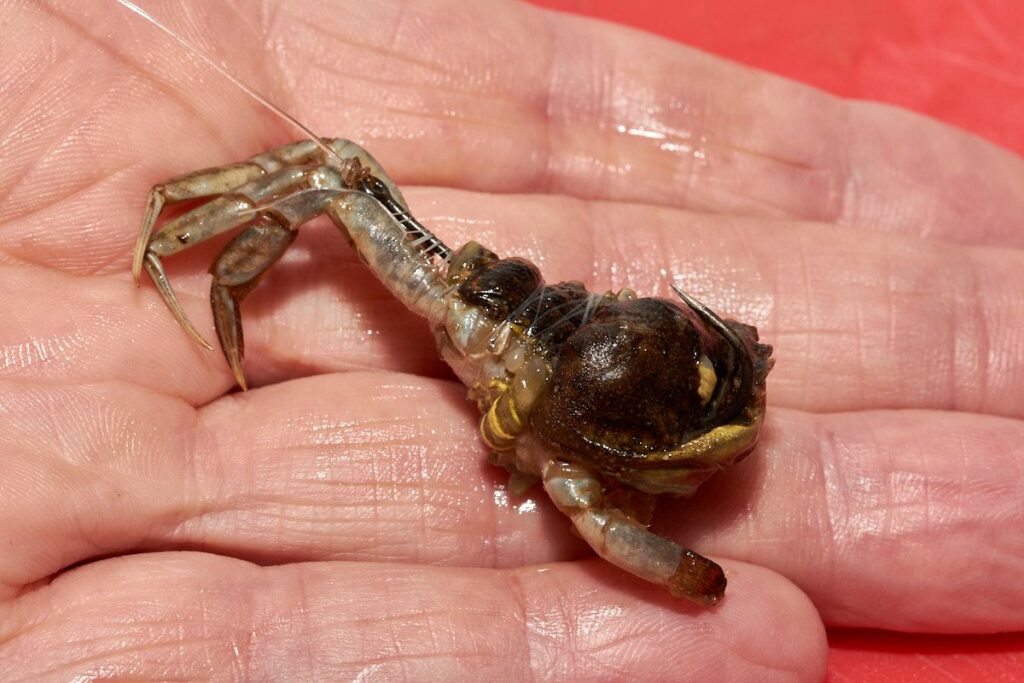
One or two small mussels should be enough on the Aberdeen size 2 and again secure it with a few wraps of bait elastic, the fine elastic being best. Aim to form a small sausage shape.
Sandeel baits are also effective. Cut small sandeels in half, or use sections of bigger sandeels, but pair the baits down to suit the smaller hooks. Again use bait elastic to secure the baits in place.
On the beaches, then keep your casts short on the flooding tide, no more than 30-yards, and the coalies are often much, much closer. You can often catch them when your leader knot is visible between you and the breaking surf. They only need a few inches of water to swim in.
We prefer to position ourselves near the rocky headlands at each end of the beach or where there is rough ground close in and fish the surf. Also, look for small gutters or gullies that run close to the surf line and fish these as the coalies will run through them.
Coalies will also be close to where small streams flow across the beach. This only applies when there is no flood water evident, but a little freshwater ingress seems to suit the juvenile coalies.
If the surf is not too high and there's no weed, try positioning your rod tips at an angle or parallel with the surf and drop the tips as low as is practical. This will give you maximum bite detection at close range, plus keep the baits tight on the seabed where the fish are hunting.
It's best to keep the baits anchored at all times, so always fish to a release wire lead and this will aid self-hooking of the fish, too.
If you fish inside harbours, then fish a rig that has a hook fished just up above the seabed and one that is hard on the seabed, typically a 1-Up/1 Down rig and use shorter 12-inch hook snoods with smaller size 2 to 4 hooks and small baits to limit bait movement in the tide. This rig also works from piers and breakwaters, but expect the fish to be tight into the structure.
On these man-made structures and inside harbours, you can also have fun with light float tackle and a spinning rod just working a small cigar-shaped float with a bait positioned just up off the bottom and tight into the rocks and harbour walls. The take of a coalfish is instant, and the float will dip instantly, it's there one second, gone the next!
Up in Scotland, you can also catch coalies on light spinning gear and any small chrome spinner between 3/4oz and 1.5ozs. Good ones are Wedge type spinners and the Abu Toby series, but anything chrome works well. This works best when spinning over rough ground.
About the coalfish
Coalfish have many common localised names including saithe and the younger inshore fish being called podley's in Scotland, billet along the Northeast coast of England, coley in England, black jack's and sometimes glassan or glasshan in Northern Ireland, and Pysgod Ddu in Welsh, the latter due to their dark green to black backs. The abbreviated common name in the UK is "coalie".
Confusingly, on the east coast of America, this same species is referred to as "pollock" or "Boston blues". In Spanish, coalfish are called palero or Bacalao, and in French, it is Lieu Noir or Colin Noir, noir being the reference to the black back.
Although the flesh is grey, and many say it has a cotton wool like texture with little taste, there is a commercial value to this fish as being a shoal fish, it is caught in large numbers by trawlers. The main UK commercial catch goes to the French market, with smaller general markets throughout Europe. The flesh can be salted and smoked to achieve a salmon-like colour, and this is called "Sea Salmon" in Germany. It is also used extensively for cat food products.
There were some huge coalfish recorded in the early days of wreck fishing from the mid to late 1960s and 70s. Their size just kept creeping up through the next two decades, and in 1986 the existing British Record Boat Caught coalfish was caught over a wreck south of Plymouth at 37lbs 5ozs by a Mr D. Brown.
Anglers were drawn to this species because of its fighting ability, and it's tendency to crash-dive during the fight, ripping many yards of line off the reel. It remains a popular target, though for the very big fish anglers now travel to the Norwegian fjords where coalies regularly top 30lbs in weight.

Coalfish identification
It's unlikely, but the coalfish and pollack inhabit much the same water, so there is a chance of misidentifying them. Several indicators are there for relatively instant recognition of the coalfish. The jaw protrudes only very slightly on the coalie, but the jaw is visibly longer than the upper jaw in the pollack. The real giveaway is the coalfish's lateral line, which is virtually straight and noticeably white running from the gill cover to the tail. The lateral line on the pollack, in contrast, has a noticeable curve over the pectoral fin. The coalfish's forehead is also more round when viewed from the side profile.
The colouration is a dark green to black back, quickly giving way to dull silvery sides and belly.
Coalfish distribution
Coalfish are found from the Bay of Biscay, throughout the English Channel and the North Sea, all along the Norwegian coast and round to beyond the Russian border. They are common around Iceland, too.
They are residents around the whole of the UK and Ireland but are a cold water loving fish, so the better numbers tend to concentrate in deeper water and the further north you go.
Since the early 1980s, the coalfish have reduced in numbers inside the English Channel, with big wreck fish now far less common. This is thought to be due to commercial overfishing and warming seas pushing the cold water liking coalfish further north.
They generally spawn from January through to late April, but it can be later after colder than average winters. Typical depths for spawning are 100 to 200-metres. The eggs and larvae then drift near the surface carried along and distributed by natural sea currents to the coastal nursery areas.
Coalfish habitat
The juvenile fish live inshore in harbours, estuaries, and are common off the beaches, especially rocky beaches and deeper water off open rock ledges. But at a weight around 2lbs, they make a natural migration offshore and seek out either rough reef ground with rising pinnacle rocks or more so wrecks.
Juvenile fish will live in rock pools in the north, but typically run sandy surf beaches in just a couple of feet of water. The coalfish has been recorded deeper than 300-metres, but their natural depth is down to 200-metres offshore.
Coalfish diet
As juveniles, they eat worms and mussels, small crabs, and sandeels. As they grow and reach adulthood, their diet changes to be wholly fish, mostly sandeels, herring, mackerel, small whiting, pout, poor cod and rocklings.
Coalies have been caught commercially to over 70lbs, but in UK waters currently, 20lb plus coalies can be classed as huge, with anything over 15lbs classed as a specimen. In Norway, you have a real chance of 30lbers, and just possibly a 40lb plus fish, especially in the far north.
Boat fishing
Season
Like so many fish, the coalie can be caught throughout the full 12-month period in UK and Irish waters, especially over wrecks. The bigger fish are best targeted from October through to April when the water temperature is colder and the fish more active. This especially applies in the southern half of the UK where summer catches tend to be dominated by smaller sub 5lb fish, generally speaking, with an influx on to the wrecks of bigger fish from October onwards.
These shoal fish are often of a close uniform size and available in large numbers, especially over deep reef ground. When you come across a shoal of small coalfish, it can prove impossible to get through to reach bigger fish or different species below them.
Tides
When both wrecking and reef fishing, the tides are important in so much as they, along with the wind, dictate the boat's drift speed. Ideal conditions are small neap tides and minimum windage so that the drift of the boat is both predictable and slow. This keeps the boat over the target wreck or reef, and the fish, longer maximising catches.
In windier conditions, look for a wind direction that blows against the tide's flow. The wind helps to slow the boat's drift, and again it keeps you over the fish longer.
Generally speaking, the bigger tides will, in many areas, see a fast tide flow and fishing in deep water over reefs and wrecks becomes more difficult. But not all areas see a fast tide run during the spring tides, and if the skipper can find target marks away from the main run, then fish can still be caught.
The state of the tide will affect the shoals of coalies. Typically, they drop down tight around and just above the wreck or reef. Usually, just down tide of it in the slack water bubble created as the tide flows over the structure. This lifts the main tide flow in the water column and as it does so, creates a bubble of slack water underneath. As the tide flow eases towards slack water, the shoals of coalies will lift in the water column.
Coalfish are more contrary and less predictable than pollack when it comes to how the tide state affects this change of water depth. This is a generalisation, we know, but something we've seen many times in the past. The bigger coalfish will stay fairly tight to the reef or wreck base, often just below the main pollack shoals. The smaller shoal coalfish will tend to be much higher up in the water and often above the main pollack shoals. It's not uncommon to find coalfish hanging in numbers in mid-water in overall depths of 300 to 400-feet with the pollack just 20 to 30-feet off the seabed. If you want coalfish, then really search the depths to find them. A good way to do this is to have anglers all fishing at different depths until the fish are located.
As for feeding over wrecks, coalfish are voracious and will feed heavily, but this tends to be concentrated in the first two to three hours of the flood and ebbing tide with catches reducing either side of slack water. When the target fish are smaller on reefs, they will feed whatever the conditions.
Something to bear in mind when wrecks are inundated with huge numbers of coalies up to about 4 or 5lbs is that they tend to beat any bigger fish to the lures. A good skipper will note exactly which wrecks have the smaller coalfish shoals present and move off these onto wrecks where they are not present. This scenario sees the bigger double-figure fish caught when they do not have to compete with the smaller fish.
Habitat
Smaller coalies will be present over rough ground, but they will gather in smaller clusters, not bigger shoals necessarily, around any rising peaks or on ground that is very uneven with a mix of smaller and much bigger boulders. It's a case of drifting over this ground until you come across pockets of fish. There is evidence to suggest that one or two coalies will live with pollack of about the same size over and around a specific bit of ground.
Reef ground with high rising rock pinnacles offers much better prospects with single bigger coalfish often resident around their base. You rarely get the numbers of fish on this higher ground, but you will get better quality.
Coalfish of all sizes love wrecks. It's obvious why. Wrecks not only deflect the tide sheltering them, but wrecks hold and attract a vast amount of food fish such as sandeels, sprat and small whitefish. The bigger fish will always be tight to the wreck itself, often right in amongst the wreckage. However, though present on whole wrecks, the smaller shoal fish prefer wrecks that have blown up and split in two on the way down, throwing a wide debris field around them. These tend to be the wrecks that produce the larger numbers of fish, but not necessarily the biggest fish. On the wide debris field wrecks, the shoals can be huge and spread across the whole wreckage area. On wrecks that have gone down intact without breaking, then expect the coalfish shoals to be more compact and closer to and immediately above the wreck or in the downtide bubble of slack water.
Weather Patterns
Weather patterns do not overly affect the coalfish shoals. What prolonged rough seas will do is push the shoals deeper, so if they were on shallower wrecks and reefs closer to shore before the blow, then expect them to have moved out deeper as the blow passes through and the seas start to ease.
Periods of calmer weather improve water clarity, making a difference to catches. Ideal conditions are clear water. Any suspended sediment in the water seems to harm catches.
Even though we're fishing at depth mostly for coalies, you'll find that days when there is an overcast sky will fish better than days when the sun is high and bright. On overcast days the light levels reduce as there is less direct sun to penetrate through the water column. Also, on dull days, the fish will tend to be higher in the water column, and deeper down when the light levels penetrate deeper in bright sunshine and clear skies.
In shallow inshore water, the light levels become much more important, and the fishing will be far more consistent on dull days than bright days. Again, expect coalies to be tight to the seabed in clear skies, but more likely up in the water column on dull and overcast days.
If you're able to fish a wreck or reef as the light levels fall towards dusk, then anticipate a gradual rise in the water column of the coalfish shoals. They may even push bait fish right up to the surface layers even in 200 to 300-feet of water at this time. The opposite applies if you begin fishing as dawn breaks. The coalfish will be higher in the water column to begin, but then drop deeper as the light levels increase.
Tackle
In shallow inshore waters, a light 12lb class rod with a multiplier holding 300-yards of 20lb braid is ample for any coalies you're likely to hook. Some anglers looking for the maximum sport will change to a 9ft spinning rod rated to 3ozs and match this to a size 4000 reel loaded with 20lb braid. Even a 4lb coalie can fight hard on this gear making short searing runs.
Over reefs and wrecks, heavier tackle is needed. A sporting soft-tipped rod with a fast action in the upper middle section feeding into a stiff butt is perfect. The reel to go with this rod is typically a multiplier holding 300-yards of 30lb braid, plus a little backing. Ideally, given the depths you might be fishing, choose a faster retrieve model, something with a gear ratio around the 6:1 mark. This means you can retrieve tackle from the depths much quicker maximising fishing time and making light work of winding in, which with slow retrieve reels can be physically draining over a day's busy fishing.
If fished direct to the terminal tackle, braid will inevitably come into contact with wreckage and debris. If you add a short shock leader of fluorocarbon with the same breaking strain as the braid, this will protect the more expensive braid and limit tackle losses due to line abrasion. As we say so often, this short section of clear line also helps to give a separation between the coloured braid and the terminal tackle. This can be very important when fishing deep clear water when visibility from the fish's perspective is more distinct. This simple addition can double your catches on a difficult day, which is why we keep mentioning it.

Rigs
At the depth we're generally fishing, rigs need to be simple and tangle-proof. Here at TSF we also like to reduce rig components to a minimum to reduce both the cost of lost tackle, but also to limit the chance of tackle snagging in the wreckage, plus to reduce as much as possible the visual effect on the fish of the terminal tackle as it takes the lure.
Whitby Rig
A rig we particularly favour is the modified Whitby rig. It's minimalistic but exceptionally effective. Here's how we tie it.

1. On to the shock leader tie on a size 2/0 American Snap Swivel.

2. To the same eye you tied the leader to, tie on 7ft of 30lb Fluorocarbon line.

3. To the Fluorocarbon tie on the lure of your choice.

4. The lead weight attaches to the link on the Snap Swivel.
The use of the weighted lure on this rig is vitally important. The rig is free to descend at full speed down through the water column. When the lead weight hits the seabed, immediately start to wind in and retrieve line. As the lead weight is coming back up, the weighted lure is still descending, and it's the inertia of the weighted shad still descending as it passes the lead that will pull out any tangles or twists in the hook length.
Mostly, a 7ft hook length is enough directly to the lure. However, if you find that you're not getting takes, or takes are unsure with the fish just plucking at the tail, then lengthen the hook length by 2 or 3-feet. This gives the lure slightly more movement, but more importantly gives a greater separation area between lead weight and lure, which can make a major difference.
This rig can also be modified instantly into a hopper rig where the lead weight is only raised off the seabed a few feet, and then the rod tip is lifted up and down to hop the lure up and down just above the seabed. This is a deadly method for bigger coalfish if you're willing to risk the lure right in the wreck at deck and debris level. When changing to a hopper rig, we normally prefer just 4ft of heavier 40, or even 50lb fluorocarbon or stiff mono as the hook length. When working the lure right in amongst the snags, the heavier hook length offers better abrasion resistance. The stiffer nature of the heavier hook length further eliminates any tangling issues.
Flying collar rig
In our opinion, the Flying Collar Rig is now outdated. It is a very effective rig, and much loved still by many anglers which is why we've included it, but the reality is that it needs a flowing tide to work effectively, plus it has to be let down to the seabed very slowly to avoid the long trace tangling.
- Begin with 20-inches of 50lb clear mono.
- At one end tie on a size 4 rolling swivel.
- On the free end of the 50lb mono slide on a hollow plastic or metal boom. A 10-inch boom is ok, but longer booms are better and reduce tangles better.
- Slide on a 5mm bead and then tie on a size 4 rolling swivel.
- The hook trace is between 10-feet and 15-feet long and should be 20lb Fluorocarbon or clear mono.
- Cut the trace in the middle and tie in another size 4 rolling swivel to help reduce line twist.
- Now tie on the lure of your choice, typically an artificial sandeel, Firetail worm, or shad.

This rig is ok for retrieving lures up through the water column, but that's it. As mentioned, it must be let down to the seabed very slowly with occasional pauses; otherwise, the long hook length can tangle with the boom and the shock leader. To help minimise this happening, make sure you cut the rig knots' tag ends as close to the knot after full tightening as you can. Often the long trace will hang itself up on a tag end and cause repeated issues if you ignore this point.
When the tide is flowing strongly a 15ft hook length should be ok, but reduce by a third during slack water periods.
2-Hook Killer Gear
This can be a very effective rig for shoal coalfish if you want multiple catches. It presents both a lure and bait together to maximise the visual and scent combination, so it is a good one to use if the water carries some colour.
- Begin with 8-feet of 80lb clear mono.
- At one end tie on a size 2/0 snap link swivel to take the lead weight.
- 2-feet above the snap link swivel, tie in a 10-inch stand-off loop using an 8-turn blood loop knot.
- 3-feet above this tie in another 10-inch blood loop.
- To the free end of mono tie on a size 2/0 swivel.
- Cut the blood loops near to the rig body knot to form a single hook length.
- Slide on a plastic muppet and a bead on to each hook snood.
- Finish each hook snood with a size 6/0 O'Shaughnessy pattern hook.

The way the muppet is rigged is important. Cut just the tip of the nose off the muppet leaving a hole just big enough for the line to pass through. Slide on an 8mm plastic bead, then tie on the hook. The bead and the muppet now slide down to butt up against the eye of the hook, but can't pass down onto the hook shank. All that's left to do is to bait the hook with a small fillet of mackerel, squid or herring.
The muppet adds colour, but the legs also give movement and vibration, and coupled with the bait scent, it makes it easy for the coalfish to find the lure and bait. Use smaller muppets up to about 4-inches for this.
Commercial white cod feathers
These are excellent takers of coalfish, especially when they are feeding on small prey fish such as sprat. They are usually made on a very heavy commercial mono and come as a six-feather rig. They need to be reduced to just three feathers for angling purposes. Don't try to be greedy by fishing more as you could get a 5lb plus coalie on each feather and they all want to go a different way, usually resulting in a breakage. They are most effective if the hooks are baited with fish bait such as mackerel, bluey or squid.
The fishing technique is simple with the feathers fished on a tight line and movement added by simply lifting and lowering the rod tip a couple of feet. Presented in this way they imitate a small shoal of fish rising and falling in the water column.
To add further attraction, try fishing the feathers with a luminous green coated lead weight. This is especially effective in very deep water.
Lures
With so many artificial lures available nowadays it's hard to pin down just a few top performers. In truth, on their day, most lures will catch fish. However, it makes sense to try and match the type of prey the coalfish are currently feeding on as near as you can. This means we need to carry a few patterns in different sizes.
Without doubt, shad patterns are deadly for the bigger fish, especially those between 3-inches in length and 6-inches. Look for those with a thin tail section but with a large wide tail. These will give the best movement and vibration in the water. A good one to judge others by is the Berkley Ripple Shad, Berkley Powerbait Pulse Shad and anything similar.
If you like the look of a shad pattern, don't worry if it does not come in a weighted version, just use a jighead or lead-head, the effect is the same.
Sandeels are must-have lures too - these need to be in sizes from 4-inches to 10-inches, again with a wobbling tail. Savage Sandeels and the Berkley Powerbait sandeels are both excellent. We also rate the grub type, or Mr Twister lures, especially the black-bodied ones with a brighter red, orange, or green firetail.
Colour is also important. Good cold colours to carry are black, red and green. These are good choices in clear seas but with low light levels entering the water. These colours give a dark shadow or silhouette that the fish can pick out from below and give chase.
Look at yellow, orange, rhubarb and custard and pink in the hotter colours. These are best used when the water has a hint of colour after a storm. That said, coalfish are different from pollack and seem to take hot colours better. We'd have no hesitation in trying a lumo green lure or a hi-viz pink in really murky water as these will consistently take coalies.
We also like clear or transparent lures and have done well on these in the gin-clear Norwegian fjords for coalies, so a few of these are also worth carrying.

Technique
We'd probably choose the hopping rig for reef fishing as the best option, to begin with. This needs the weight to be dropped to the seabed, and as the weight is felt to touch bottom lift the rod tip and retrieve 2-feet more than the total length of the hook length, so with a 4ft hook trace retrieve 6 to 7-feet of line. Now simply work the rod tip up and down a couple of feet or so at a time so that the lure lifts nose up a short way, then drops back nose first. This tactic only works really with non-stretch braid lines. Mono lines stretch too much and nullify the rod tip lift when fishing at real depth. The coalies, especially bigger ones, will hit the lure as it drops. If you're not getting bites, then lift the lure higher until you find the fish. You get one slam on the rod tip, and then the fish takes off pretty much setting the hook itself.
Over a wreck, then it's likely you'll be using the Whitby Rig with the longer 7ft to 9ft hook length for retrieve fishing. Again, let the weight descend until it hits the seabed, then instantly start to retrieve using a slow to medium pace. Count each full turn of the reel handle as the lure edges upwards, and when a bite comes, it gives you an idea of where the fish are holding in the water column. This will keep altering as the tide changes, so make this a natural part of your fishing. If you don't get takes, then try a faster and faster retrieve, or a slower retrieve with brief pauses once the lure is up safely off the bottom and away from snags. Takes from coalies are usually decisive with a sudden gulping in off the lure and the rod tip bending over.
Also, listen to what the skipper says regarding where the boat drift is related to the approaching wreck. As you approach the wreck, and with your terminal tackle touching the seabed, deliberately hold the lure on a tight line above the seabed even allowing it to lift slightly in the water column as the line comes tight, but when he says "wreck approaching" release line quickly so that the lure hits the seabed again just before the boat is over the wreck. Now, without retrieving line yet, just let the lure lift up at a shallow angle off the seabed as the line tightens. This brings the lure upwards over the wreck at a shallow but ever-rising angle. This can be deadly when you get it right. Coalfish are more aggressive takers of lures than pollack, and you'll feel a sudden jag on the rod tip as the lure is taken.
The 2-Hook Killer gear is a simple form of fishing. Just let the tackle down to the seabed then gradually lift it up in the water column by lifting and lowering the rod tip and retrieving line as you drop the rod tip. Again, takes from coalies are sudden crashes of the rod tip as the coalie takes the lure and bait.
Boat fishing for coalfish top tips
- Coalfish will take the same lures as pollack, but they do show more of a tendency to hit very brightly coloured lures such as hot orange, luminous green and yellow, also fire red. When you want coalfish and are catching just pollack, try switching to a "hot" colour as often this will pick out the coalies.
- In addition when using a flying collar rig and bites are slow, lengthen the lure trace by a few feet, say up to 15-feet and see if this makes a difference, it usually does. You'll also find you catch more fish using fluorocarbon lure hook lengths than you will with mono.
- Always experiment with the rate of retrieve when retrieving your lure. Coalies sometimes want a slow retrieve, and this seems particularly so on overcast days. On clear sunny days with good water clarity speed up the retrieve. Try and alternate a little the retrieve rate by adding a sudden burst of speed to the lure as if it's darting away from a predator. This can often get a response from an otherwise uninterested fish.
- When lure fishing offshore try adding a small lumo bead above the lure on the hook trace, a 3mm bead is enough, but use two beads back to back if the water is more coloured or light levels very low, say on a drizzly, foggy day. The luminous green will illuminate at depth and help draw the fishes attention to the lure.
Shore fishing
Season
In recent years, due to warming seas and milder winters, the best of the winter shore coalfish action is north of a line drawn from North Wales across to the Northeast. South of that line coalfish can be more localised in distribution, mainly near rocky coastal areas, especially in the west of the country.
Although very small coalfish (billet) can be caught in harbours and estuaries throughout the year, the season for shore caught coalfish is typically from late October to late March along the open coastline. Their numbers build inshore from that mid-October period, but you see the best numbers in the southern section from Christmas through to mid-March. In the north, they are far more frequent and wider spread.
Tides
For most beach fishing you'd be wise to choose any rising tide in the few days before the biggest spring tides. The fish are more actively feeding then and will range further afield. The beaches tend to fish less productively during the neap tides but will still produce.
That said, on the neap tides, some of the estuaries, especially the smaller ones, can really come into their own due to the faster tide run in the main estuary channels and you'll catch coalies from this main channel as they range up and down, but still within close proximity to the sea itself.
It's the same in smaller harbours. They use the flooding tide to range as far up as the saltwater content allows them, but no further. They will do this on most tides, but the biggest numbers of fish will be evident on the rising tides up to the spring tides.
They feed best on the incoming flooding tide and much less on the ebbing tide. They like a little water flow, so always bear this in mind.
Habitat
They love clean sandy beaches with rocky headlands and cliffs either side of them, especially if there is rougher ground further out. They work their time on the rough, then swing in with the flood tide to run the surf line where the flooding tide washes food out from the sand.
They are found over rougher broken ground, also sometimes on rocky ground, though their preference is for some sand when tight inshore.
Small coalies are also common off breakwaters, jetties and piers, also harbour walls.

Weather patterns
Coalfish will run in a decent surf on surf beaches, but they don't like it too rough with a high surf. They like to run very tight inshore, often less than 30-yards from the sand line, so heavy surf is not to their liking. Look for a predictable, light to medium surf with some width to the surf tables.
They can be caught in daylight if the sea is coloured and the sky cloudy, but they are best fished for in the dark hours, especially off the beaches. It's less important when fishing off man-made structure and inside harbours and estuaries.
Tackle
Due to the terrain you're fishing with potential weed, also rougher ground patches, stick to a standard 4-6oz beachcaster between 12ft and 13ft long in partnership with a multiplier reel such as the Penn 525 series, the Abu 6500's, or the Akios and Daiwa equivalents. Load the reels with 18lb mono and a shock leader.
The other obvious outfit is a 13ft to 14ft continental style beachcaster with a shallow spooled 7000 sized fixed spool reel. Load with 30lb braid mainline and add a 60lb to 80lb braid shock leader.
Inside estuaries you may get away with a bass rod capable of casting 2-4ozs, a small 6500 multiplier loaded with 15lb line and a 30lb shock leader, or a 5000 sized fixed spool with 20lb braid and 40lb braid shock leader. This outfit gives a bit more fun for a fish that can fight well above its weight, but things like tide run and weed will govern your everyday choice.
Rigs
You don't need complicated rigs for shore coalies. We use our reversible 3-hook flapper, and it will maximise your catches, not just of coalies, but of other species at this colder time of year.
3 Hook Reversible Flapper Rig

1. Start with about 64-inches of 60lb clear mono. Tie on a Gemini lead link at one end.

2. Slide on a rig crimp, a 3mm oval rig bead, a size 10 swivel, another rig bead and a crimp. Repeat this sequence to give you three full individual sets of crimps, beads and swivels. Leave these loose for now.

3. Complete the rig by tying on an inverted (upside down) Gemini lead link to the tag end of the rig body line.

4. The first hook trace swivel needs to be placed just one inch below the top Gemini lead link. The middle swivel should be positioned exactly 17-inches below the top swivel, and the third again 17-inches down from the middle hook trace swivel.

5. The top hook trace needs to be the longest at about 15-inches, the second hook trace measures 13-inches, and the bottom hook trace is the shortest at just 10-inches. All hook traces are made from 20 mono or fluorocarbon and are finished with a size 2 Kamasan B940 hook for general species.
The way this rig works is that due to it having Gemini clip links at each end, you can reverse the rig. This is handy if you notice that the lowest hook well above the lead weight is catching most of the fish with the upper hooks redundant, then reverse the rig so that the hook nearest the clip link which was the highest hook, becomes the lower hook fished tight behind the weight, with the middle hook now also positioned lower. This simply means you have not just one hook in the feeding zone, but two increasing overall catches.
Don't go any higher in size than the 2 Aberdeen hooks. Even a bigger 2lb to 3lb coalie can easily be landed on these.
Baits
When in the surf the coalies will take all the usual baits including black and blow lug, rag, razorfish and small sand clam.
The best baits though are fresh and frozen crab and mussel. The crab needs to be cut into sections just big enough to fill the hook bend and shank, leaving the hook point clear, then binding it quite tightly with a few wraps of bait elastic into a rough sausage shape.

One or two small mussels should be enough on the Aberdeen size 2 and again secure it with a few wraps of bait elastic, the fine elastic being best. Aim to form a small sausage shape.
Sandeel baits are also effective. Cut small sandeels in half, or use sections of bigger sandeels, but pair the baits down to suit the smaller hooks. Again use bait elastic to secure the baits in place.
Technique
On the beaches, then keep your casts short on the flooding tide, no more than 30-yards, and the coalies are often much, much closer. You can often catch them when your leader knot is visible between you and the breaking surf. They only need a few inches of water to swim in.
We prefer to position ourselves near the rocky headlands at each end of the beach or where there is rough ground close in and fish the surf. Also, look for small gutters or gullies that run close to the surf line and fish these as the coalies will run through them.
Coalies will also be close to where small streams flow across the beach. This only applies when there is no flood water evident, but a little freshwater ingress seems to suit the juvenile coalies.
If the surf is not too high and there's no weed, try positioning your rod tips at an angle or parallel with the surf and drop the tips as low as is practical. This will give you maximum bite detection at close range, plus keep the baits tight on the seabed where the fish are hunting.
It's best to keep the baits anchored at all times, so always fish to a release wire lead and this will aid self-hooking of the fish, too.
If you fish inside harbours, then fish a rig that has a hook fished just up above the seabed and one that is hard on the seabed, typically a 1-Up/1 Down rig and use shorter 12-inch hook snoods with smaller size 2 to 4 hooks and small baits to limit bait movement in the tide. This rig also works from piers and breakwaters, but expect the fish to be tight into the structure.
On these man-made structures and inside harbours, you can also have fun with light float tackle and a spinning rod just working a small cigar-shaped float with a bait positioned just up off the bottom and tight into the rocks and harbour walls. The take of a coalfish is instant, and the float will dip instantly, it's there one second, gone the next!
Up in Scotland, you can also catch coalies on light spinning gear and any small chrome spinner between 3/4oz and 1.5ozs. Good ones are Wedge type spinners and the Abu Toby series, but anything chrome works well. This works best when spinning over rough ground.
Top tips for shore coalfish fishing
- Adding a single small 3mm luminous green bead above the bait when surf fishing can help increase bites, especially if the water is coloured after storms. Remember to charge this briefly for each new cast with either your headlight or carry a UV torch to stimulate the luminescence.
- To keep tangles in the surf down to next to nothing, the use of stiffer fluorocarbon hook lengths is recommended. They are not line shy, so in rough weather go up to 30lb fluorocarbon if surf conditions suggest it prudent.
- A good tip with the coalies being so close in is, when you re-bait your rigs, throw any bits of old bait off the hooks into the surf in front of you. This forms a little groundbait trail that can briefly bring and hold the fish in the area, again increasing your catch rate.

